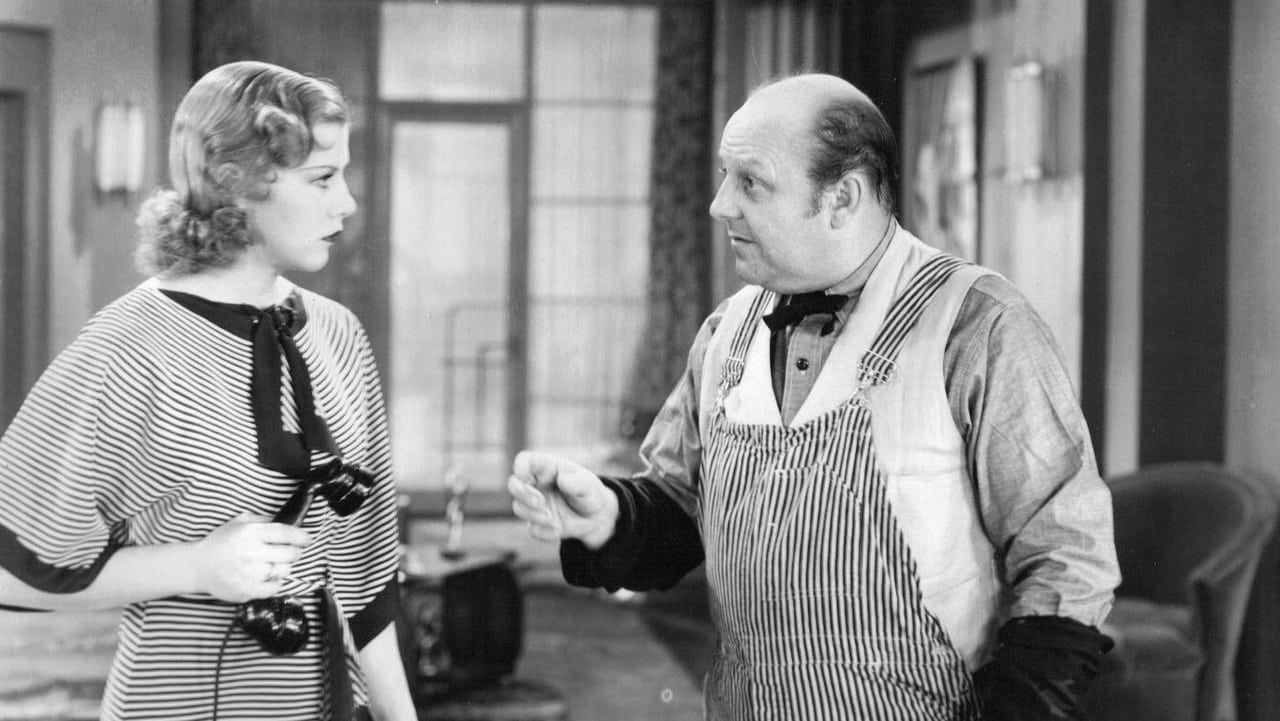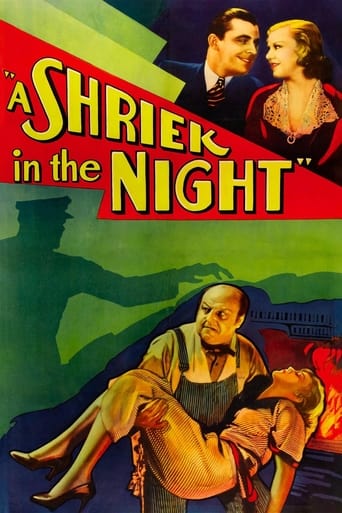

For a Poverty Row effort (Allied Pictures), A SHRIEK IN THE NIGHT has unusually high production values and a far better cast (Ginger Rogers, Lyle Talbot, Purnell Pratt, even Louise Beavers) than such movies could normally command. Actually, I'm puzzled as to what Ginger Rogers was doing here at this point in her career. Some sort of loan-out from her new studio, RKO? Was RKO responsible for the realistic outdoor shooting and the occasionally witty banter in the script? There must be some story here, but I've never come across it.In any event, a handsome young couple wisecracking their way through a murder mystery was a staple of thirties' filmmaking and stayed that way for at least for another fifty years (the TV series Moonlighting would be the latest 'New Hot Thing' of its time, which was at least 50 years after SHRIEK). This was a pretty early example of the genre, and not the worst that it would produce by a long shot. Not exactly a sequel to THE THIRTEENTH GUEST though it also was about a murder and featured the same two leads, SHRIEK is much more in the spirit of THE THIN MAN as our pair of rival reporters (Rogers and Talbot) banter their way through a murder investigation ("What's romantic about a speakeasy?" "Man! Don't be vulgar") that is heavier on the comedy than it is on the mystery (it's not a good sign when you have to spend two minutes at the end of your picture explaining what the plot had been about).Lyle Talbot had sort of reached his level as the star of movies like this; Ginger Rogers, of course, was about to reach her level as the star of movies like TOP HAT. They raise material which otherwise was potentially watchable to material that is--well, watchable. One reviewer suggested that it would have been better had Ginger gone off to solve the mystery with Detective Purnell Pratt as they had better chemistry than she had with Talbot, and I believe that I agree with that idea. Still, with a fast forward button in hand, SHRIEK does provide the viewer with some pleasant scenes.
... View MoreSome rich guy takes a spill off a block of flats to the pavement below. The detective involved in the case thinks it isn't just a normal accident, especially when it turns out that the dead guy's secretary, Ginger Rogers, is really an investigative journalist. It seems the guy had mob connections (the gangster also has an apartment in the same building), but, if the mob whacked him, what's the meaning of the business cards that have a picture of a snake and the words 'You will hear it' written on them?I'll say no more about the plot as it works quite well up to a point, until the film non-chalantly reveals the killer about three quarters of the way through. Even though the mystery element is dispensed with, the film works well as our killer now targets the people getting close to discovering his identity. There's a lot of noir elements here as we see the killer's shadow a lot, and a lot of intrigue as two rival journalists try to outdo each other before joining forces. I almost got a giallo feel from this one (even though the giallo was far off in the future), what with the calling cards and such like. It's only an hour long so shouldn't tax your patience in any way. I'm beginning to really enjoy these old mystery films.
... View MoreThe opening seconds of this Z-Grade melodrama promise more than the rest of the film delivers. A body flies out of a window. Suicide or murder? That's what two friendly reporters on rival newspapers want to know. They are Ginger Rogers and Lyle Talbot whose initial sparring (that predictably leads to romance) is one of the only amusing things in this creaky crime drama that needed to be oiled, even back in 1933. Frequent lulls of no dialogue or action slow this down to a turtle race. Sudden uses of shadows to show a murderer in a gas mask or darkly lit scenes of mayhem can't help this rise past mediocrity. Rogers, fresh from another Z-Grade melodrama ("The Thirteenth Guest") must have either been bored or broke, or waiting for dance rehearsals to start so she could learn "The Carioca" for "Flying Down to Rio".Louise Beavers adds a bit of amusement as the feisty maid who declares, "Yes, I ain't going' in!" (to a morgue), insisting that she's seen enough dead bodies in one day to last her a lifetime, and agreeing to go to jail, preferring to be with live people than dead ones in a freezer. This seems like one of those slow-moving melodramatic plays that toured around the United States and England's smaller communities prior to the invention of movies.
... View MoreA dummy falls from a balcony(..actually it's supposed to represent a man, but many will giggle a little at how unrealistic it is with the flailing arms as the body impacts with pavement)and detectives consider it possible homicide. The man who fell to his doom, a Mr Harker, had a temporary secretary, Patricia Morgan(Giner Rogers)working in his apartment who in fact is a reporter infiltrating the man's privacy trying to uncover his ties to a gangster, Joe Martini(Maurice Black). It's soon discovered by Inspector Russell(Purnell Pratt)that Harker was perhaps thrown off a balcony in his lover's room. The female lover was found strangled(..but we see a person's silhouette with a mask cutting off the gas, telling us that it's in fact a mystery assassin attempting to throw detectives off the scent)and later her husband, Mr. Colby, police's number one suspect, is found dead, potentially of suicide. Patricia has the scoop, but her current(..well, sort of)boyfriend, Ted Ford(Lyle Talbot)steals her story, having her believe that he's from her newspaper. Losing her job when the big story turns up on the front page, almost word for word the way she had intended, of Ted's newspaper, Patricia will coordinate a relationship with Russell, remaining in Harker's Penthouse sweet, attempting to discover any possible evidence that might provide a link to the killer's identity. Meanwhile, Ted tries to make nice, forging a team with Patricia to solve the mystery. A letter from the killer(..to Harker, found hidden in a small compartment in a dresser drawer) is discovered by his always-hysterical housekeeper, Augusta(Lillian Harmer, in a hideous performance, as the comedy relief but it's excruciatingly forced and over the top to a ridiculous degree)which relates to an innocent cabbie sent to the chair for a murder of someone who was rivals with Harker. Acting suspiciously is the apartment's janitor, Peterson(Harvey Clark)who we see feeding a recording of a shrieking woman's voice into the ventilation to mask the sound of another killing. The janitor also has skeleton keys to every room and sneaks around like a mouse, not to mention that he listens on conversations made between Patricia and Ted..why would he be so interested? It's only a matter of time, despite Ted's efforts to keep her safe, until Patricia's life will be threatened as she gets too close to the truth.Okay little murder mystery designed as a star vehicle for the always charming and illuminating Ginger Rogers. She re-teams with Lyle Talbot(..they worked beautifully together in THE THIRTEENTH GUEST)and they have great chemistry which certainly helps rise this above it's rather decent, but unremarkable, presentation. Pratt comes off a jackass as the detective, always insulting somebody, never listening to his partner, Wilfred(Arthur Hoyt), for whom he considers an idiot. Actually, Wilfred, a very timid, meek, quiet little fellow, helps out a great deal when Russell gives him a chance to talk. Wilfred's bravery at the end resulting in a scuffle with the killer is a nice scene that allows him to be the hero as others are upstairs looking for clues. The plot is rather complex even though the killer's identity could be guessed relatively soon through obvious clues.. the finger in pointed in one direction early and never relinquishes it, so I think that's a failure in Albert Ray's work as director, not to produce effective red herrings that would keep us guessing. As a Ginger Rogers movie, I do think it succeeds, but that could be because I personally love her in practically everything. And, the unflappable, extremely likable Talbot lends great support. Some of the comedy bits with the housekeeper(..and another black stereotype, played by Louise Beavers, the maid frightened of morgues and dead people, is provided for African-Americans to cringe)are really irritating, though. Those accustomed with cinema at this time can probably adjust to the dead air that often exists making scenes between characters seem like lengthly affairs.
... View More